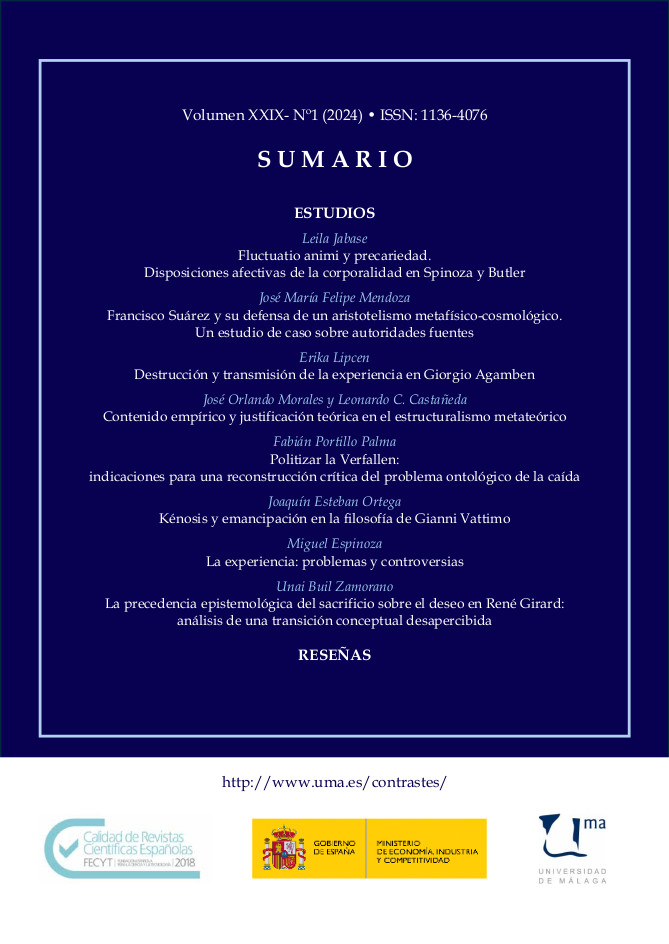La precedencia epistemológica del sacrificio sobre el deseo en René Girard
Análisis de una transición conceptual desapercibida
DOI:
https://doi.org/10.24310/contrastes.29.1.2024.16648Keywords:
mimetic desire, sacrifice, mediation, trascendenceAbstract
In the context of most studies about René Girard’s thought, it is commonly assumed that mimetic desire is Girard’s original idea about human desire as such. In this sense, mimetic desire would be Girard’s first discovery chronologically speaking. Likewise, it is also widely believed that Girard’s Anthropology and his theory about religion would later emerge from what he discovered as mimetic desire. However, an alternative interpretation is offered in this article. Certainly, what Girard finally defined as ‘mimetic desire’ was found in a second moment, thanks to his anthropological insights as well as from his research about ancient religions. Therefore, I sustain the idea that mimetic desire is not Girard’s primitive stance on human órexis, but the outcome of an unnoticed metamorphosis of his original intuitions (which he ended up abandoning) as they were explained in his first book, Deceit, desire and the novel.
Downloads
Metrics
Publication Facts
Reviewer profiles N/A
Author statements
Indexed in
-
—
- Academic society
- N/A
- Publisher
- Universidad de Málaga
References
BANDERA, C. (1975), Mímesis conflictiva: ficción literaria y violencia en Cervantes y Calderón. Madrid: Gredos.
BELLINGER, CH. (2001), The genealogy of violence: reflections on creation, freedom and evil. Oxford: Oxford University Press.
BUCHER, G. (1989), La vision et l’énigme. Paris: Cerf.
DORAN, R. (2011), “René Girard’s concept of conversion and the ‘Via Negativa’: revisiting ‘Deceit, desire and the novel”, Religion and Literature, 43/3, pp. 170-179.
DUPUY, J. P. (2016), La jalousie: une géométrie du désir. Paris: Éditions du Seuil.
DUPUY, J. y EL AUTOR DE ESTE ARTÍCULO (9 de diciembre de 2019), Correspondencia electrónica privada entre el autor del artículo y Jean-Pierre Dupuy [inédito].
GIRARD, R. (2016), Shakespeare: los fuegos de la envidia, 2ª ed. Barcelona: Anagrama.
GIRARD, R. (2012), El sacrificio. Madrid: Encuentro.
GIRARD, R. (2010), Clausewitz en los extremos: política, guerra y apocalipsis. Buenos Aires y Madrid: Katz.
GIRARD, R. (2006a), Aquel por el que llega el escándalo. Madrid: Caparrós Editores.
GIRARD, R. (2006b), Los orígenes de la cultura. Madrid: Trotta.
GIRARD, R. (2002a), La ruta antigua de los hombres perversos, 2ª ed. Anagrama: Barcelona.
GIRARD, R. (2002b), Veo a Satán caer como el relámpago. Barcelona: Anagrama.
GIRARD, R. (1998), La violencia y lo sagrado, 3ªed. Barcelona: Anagrama.
GIRARD, R. (1996), Cuando empiecen a suceder estas cosas. Madrid: Encuentro.
GIRARD, R. y MÜLLER, M. (1996), “Interview with René Girard”, Anthropoetics, 2 (1), cuestiones 1-13. http://anthropoetics.ucla.edu/ap0201/interv/
GIRARD, R. (1990), “Innovation and repetition”, Substance, 19 (62/63), pp. 7-20.
GIRARD, R. (1986), El chivo expiatorio. Barcelona: Anagrama.
GIRARD, R. (1985), Mentira romántica y verdad novelesca. Barcelona: Anagrama.
GIRARD, R. (1982), El misterio de nuestro mundo. Salamanca: Sígueme.
GIRARD, R. (1976), Critique dans un souterrain. Paris: Grasset & L’Âge de l’homme.
GRANDE, P. B. (2009), Mimesis and desire: an analysis of the religious nature of mimesis and desire in the work of René Girard. Colonia: Lambert.
HAMERTON-KELLY, R. G. (1994), The Gospel of the sacred: poetics of violence in Mark. Minneapolis: Fortress Press.
JOHNSON, W. L. (1992), Violence as grace: a ‘Theopoietic’ reading of mimetic violence in René Girard and Flannery O’Connor. Ann Arbor: UMI.
JONES, J. W. (2008), Blood that cries out from the earth: the psychology of religious terrorism. Oxford: Oxford University Press.
MOOSBRUGGER, M. (2013), “René Girard and Raymund Schwager on religion, violence, and sacrifice. New insights from their correspondence”, Journal of religion and violence, 1 (2), pp. 147-166.
PAYNE, M. (2007), Theocritus and the invention of fiction. Cambridge: Cambridge University Press.
RUIZ LOZANO, P. (2005), Antropología y religión en René Girard. Granada: Facultad de Teología de la Universidad de Granada.
WATSON, P. J. (1998), “Girard and integration: desire, violence, and the mimesis of Christ as foundation for Postmodernity”, Journal of Psychology and Theology, 26 (4), pp. 311-321.
WEBB, E. (1988), Philosophers of consciousness: Polanyi, Lonergan, Voeglin, Ricoeur, Girard, Kierkegaard. Seattle and London: University of Washington Press.
WILMES, A. (2017), “Portrait of René Girard as a post-hegelian: masters, slaves, and monstrous doubles”, The Philosophical Journal of Conflict and Violence, 1 (1), pp. 57-85.
Downloads
Published
How to Cite
Issue
Section
License
This journal provides immediate free access to its content under the principle of making research freely available to the public. All content published in Contrastes. Revista Internacional de Filosofía, are subject to the Creative Commons Attribution-NonCommercial-ShareAlike 4.0 license whose full text can be found at <http://creativecommons.org/licenses/by-nc-sa/4.0>
It is the responsibility of the authors to obtain the necessary permissions of the images that are subject to copyright.
Authors whose contributions are accepted for publication in this journal will retain the non-exclusive right to use their contributions for academic, research and educational purposes, including self-archiving or repository in open access repositories of any kind.
The electronic edition of this magazine is edited by the Editorial Service of the University of Malaga (Uma Editorial), being necessary to cite the origin in any partial or total reproduction.










5.png)
